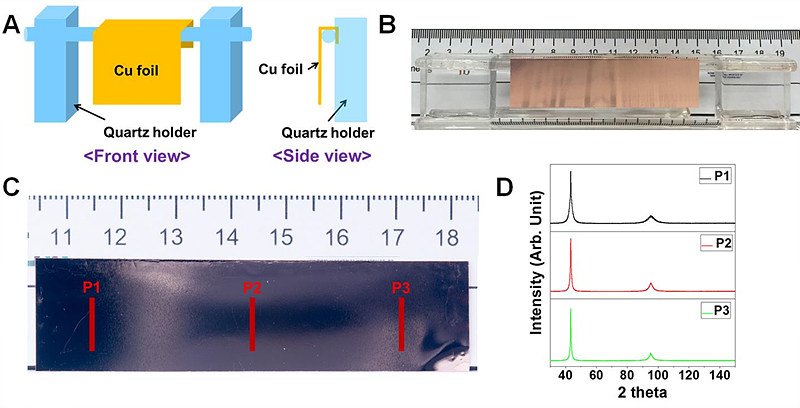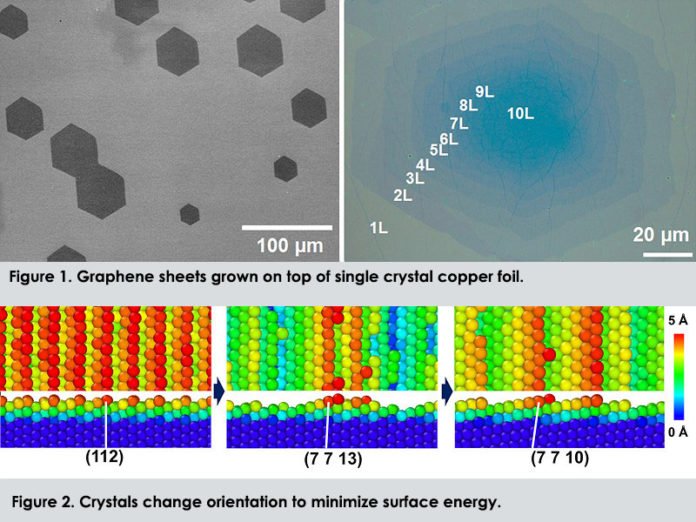A team of researchers at the Center for Multidimensional Carbon Materials, within the Institute for Basic Science (IBS), has discovered a novel method to transform economical polycrystalline metal foils to single crystals with superior properties.
It evokes the anticipations that these materials will find useful in many Science and Technology practices.
While studying about the structure of most metal materials they appear as a patchwork of different tiny crystals, bearing some imperfections on the borders between each patch. These imperfections called grain boundaries (GBs), which aggravates the electrical and sometimes mechanical properties of the metal.
As an alternative since single crystal metals have no GBs and show higher electrical conductivity and other enhanced qualities that can play a major role in multiple fields, such as electronics, plasmonics, and catalysis, such others.
Single crystal metal foils have appealed a huge attention since certain single crystal metals, such as copper, nickel, and cobalt, are acceptable for the growth of defectless graphene, boron nitride, and diamond on top of them.
This alternative choice is generally fabricated beginning with a ‘crystal seed’. Conventional approaches, such as the Czochralski or Bridgman methods, or others based on the deposition of thin metal films on single crystal inorganic substrates, achieve small single crystals at high processing costs.
To unlock the full potential of such metal structures, the IBS team led by Rodney Ruoff at Ulsan National Institute of Science and Technology (UNIST), along with JIN Sunghwan and SHIN Hyung-Joon, invented the “contact-free annealing” (CFA) technique.
CFA involves heating the polycrystalline metal foils to a temperature slightly below the melting point of each metal.

This novel method does not require single crystal seeds or templates, which limit the maximum crystal size, and was tested with five different types of metal foils: copper, nickel, cobalt, platinum, and palladium.
It resulted in a ‘colossal grain growth’, reaching up to 32 square centimeters for copper.
The inside information of the experiment varied according to the metal utilized. In the case of copper, quartz holders and a rod were utilized to hang the metal foil, like clothes suspended on clotheslines. Then, the foil was heated in a tube-shaped furnace to approximately 1050 degrees Celsius (1323 degrees Kelvin), a temperature close to copper’s melting point (1358 K) for several hours in an atmosphere with hydrogen and argon, and then cooled down.
In addition to, the scientists achieved single crystals from nickel and cobalt foils, each about 11 ㎠. The acquired sizes are limited by the size of the furnace so that one could expect production of larger foils with ‘industrial’ processing methods.
Whereas for platinum, resistive heating was utilized because of its higher melting temperature (2041 K). The current was passed through a platinum foil attached to two opposing electrodes, then one electrode was moved and adjusted to keep the foil flat during expansion and contraction.
A team expects this method to work for other foils since it also worked for Palladium.
These large single crystal metal foils are useful in several applications. For instance, they can serve to grow graphene on top of them: the group obtained very high-quality single crystal monolayer graphene on single crystal copper foil and multilayer graphene on a single crystal copper-nickel alloy foil.
The new single crystal copper foil manifested electrical properties. Collaborators, YOO Won Jong and MOON Inyong at Sungkyunkwan University, gauged a 7% hike in the room temperature electrical conductivity of the single crystal copper foil, compared to the commercially-available polycrystalline foil.
JIN Sunghwan, and his supervisor Ruoff said, “Now that we have explored these five metals and invented a straightforward scalable method to make such large single crystals, there’s the exciting question of whether other types of polycrystalline metal films, such as the iron, can also be converted to single crystals.”
Professor Rodney S. Ruoff enthusiastically concludes, “Now that these cheap single crystal metal foils are available, it will be tremendously exciting to see how they are used by the scientific and engineering communities!”
The study has been published in the journal Science.
